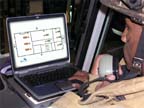
In the past year several NetTalon (Fredericksburg, Va.) System 3000 Beta sites have been operating in the Virginia region. A recent installation at the Louisiana State University Fire & Emergency Training Institute, Baton Rouge, La., demonstrates its efficacy in action to the fire community.
The System 3000 reports alarm conditions to all authorized monitoring stations within two seconds of a sensor or smoke detector going into alarm. Sensor and detector conditions depicting the nature of the evolving emergency are reported virtually immediately on a graphic representation of the building’s floor plan. Icons that represent the various sensors (heat sensors, duress buttons and smoke detectors) are overlaid on the floor plan and change color to indicate alarm conditions.
Icons representing the heat sensors display changing temperature in real-time. Smoke detectors inform the first responders of the amount of restricted visibility and potential breathing difficulty. Duress buttons display the location of personnel trapped by the fire emergency, while temperature sensors report the source of measured heat leading the responders to the source of the fire.
But the outstanding advantage of the new system is its ability to network the local fire department to the building being protected. Firefighters can examine details of a fire and begin to form their strategies before they ever leave the firehouse. The speed of the system and the ability to visualize the fire-involvement situation should greatly increase speed of deployment and efficacy of response.
Long-term investment
With a system upgrade, the developers reflected on the problems created when the centralized databases had to be reconciled between each of the two response monitoring facilities: the 911-dispatch center and the county administrative facility. Although advanced at the time of its initial creation, the basic architecture was no longer a viable solution for the increasing demands placed on the system.There were two dilemmas: using a privatized RF communications infrastructure lacked both bandwidth and viability, and the information source was misplaced and unnecessarily complicated. Since the school system had already begun the implementation of a countywide WAN to support communications between the various school buildings, a network-based approach would provide both an inexpensive and bandwidth attractive solution. Further, the developers realized that the site data that defines its configuration and status really belongs in the panel itself, not in any peripheral aspect of the system architecture. These realizations were the genesis of the System 3000 concept.
As system development progressed, the developers became indoctrinated into NFPA design procedures, standards and regulations unique to the fire industry. In 2004, the basic system design and configuration, much of it dictated by code, was completed after five years of development.
The system successfully completed FCC RF emanation and susceptibility testing by Washington Labs. It was then submitted to Factory Mutual Research Corp. testing for NFPA 72 compliance. This was completed, and the product was Listed by FMRC, in 2004. The system is currently going through the process of listing for UL864 (9th edition) and UL1076.
Victory for LSU
A preliminary real-time test series at LSU’s Fire & Emergency Training Institute started and monitored six fires. The fire department from St. George, a suburb of Baton Rouge, responded to the test fires in the conventional manner, while LSU fire institute personnel and senior commanders from the St. George company monitored the fire scene remotely.From the time each fire was started, university control personnel allowed two minutes to pass, simulating the time it takes to process an alarm signal. Meanwhile, monitoring stations were viewing smoke activity at multiple points in the building within a few seconds of the fire starting. Within the next 30 seconds, monitoring personnel could view actual fire activity and victim dummy location. All data was received a full 90 seconds before the staged fire company received the dispatch.
After dispatch, it was another four-and-a-half minutes before the real-time firefighters located the test fire and victim dummies. Control personnel watching via the system knew the fire’s intensity, location, involvement in the building, spread of smoke, victim location and victim danger long before the fire responders even arrived.
On the operations side of the equation, the system also claimed it could make important fire data available to the commander and the responding crews before they even left the fire station, theoretically allowing the commander to develop his strategy and tactics, make key, critical decisions and be farther ahead when he arrives at the fire scene.
To test this assertion, these events were simulated at LSU’s multistory burn building. Control personnel determined that the system could detect, identify and provide location of the fire and read-out conditions, like rate of rise and temperature in the affected area, minutes in advance of crews arriving on the scene.
The involved firefighters included the St. George fire department, other crews from around the state that were in for training and the institute’s own staff. Every group tested was able to gather information faster, make decisions faster, and develop sound strategy and tactics much earlier into the training scenario.
LSU’s Fire & Emergency Training Institute gears its training to the needs of the fire-fighting community. It is felt that the early information provided by systems of this sort will be especially helpful for fires in building complexes and high-rise buildings, which are major concerns of fire departments today.

Sidebar: Emergency Evacuation Goes Private
Corporate security directors more often today look to private services to provide potential emergency transportation and evacuation services. Some offerings are tied to specialty and travel insurance firms.One example: Access America of Richmond, Va., provides travel insurance that is sold through more than 22,000 travel agencies in the United States. Among its offerings are emergency transportation and evacuation services. Companies such as Access America combine travel insurance and 24-hour assistance services to give business and VIP travelers peace of mind wherever they are, whenever they need it.
Security departments can arrange emergency transportation and evacuation services for company employees traveling on business.